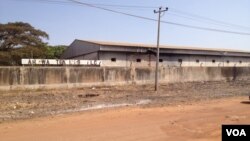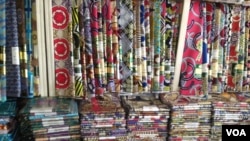KADUNA, NIGERIA —
Adasu Inalegwu, a former textile worker in northern Nigeria, now runs a commercial motorcycle taxi business to support his family. “This is in addition to the small plot of land I cultivate to grow little food to sustain my family. That is the only way to survive,” he says.
Inalegwu lost his job 10 years ago when the Arewa Textile mill closed down. He now lives in a small one bedroom house with his wife and eight children in Tirkania, just outside Kaduna.
Inalegwu’s living conditions may be crowded, but he may be among the lucky ones.
Adamu Maisantaki and many other former textile workers don’t have a piece of land to cultivate, or a small business that makes money, however meager. Every day, Maisantaki goes out looking for menial work so he can bring home something to eat.
“Many of us have no means of livelihood and no hope for another job in a country with millions of unemployed youths,” said Maisantaki. “We depend on what we get from friends and other relatives – many have seen their children withdrawn from school for nonpayment of school fees.”
It is estimated that hundreds of thousands of workers lost their jobs when the textile mills closed down throughout Nigeria over the past decade. Many have staged demonstrations over the years demanding severance payments and other entitlements.
Some have won court judgments against the textile companies, but their entitlements still have not come through because of legal questions over how to make the payments.
Boom then bust
The first modern textile mill in Nigeria started operation in 1956 in Kaduna. By 1987, the Nigerian textile industry was estimated to be the third largest in Africa, after Egypt and South Africa.
According to Nigerian Textile Manufacturers Association, there used to be 180 textile mills employing more than 350,000 workers in the major textile towns of Aba, Asaba, Funtua, Gusau, Kaduna, Kano, Port Harcourt and Lagos. Three of the biggest and oldest mills were in Kaduna, which used to be called “Textile City.
The industry was generating an estimated $9 billion in annual revenues, and government statistics indicated it directly or indirectly supported more than 17.2 million Nigerians.
But Nigeria’s textile industry began crumbling by the late 1990s. Industry analysts blamed a lack of sufficient electrical power, dwindling domestic cotton production, cheaper textile imports as well as higher energy prices, tighter industry regulation and increased financing costs.
The number of mills quickly sank from 180 to less than 25 in short order.
Reason for optimism
Early this year, Nigeria’s minister of trade and investment Olusegun Aganga, said the government was going to address the major factors hurting the textile industry, including the difficulties faced by cotton farmers. Other government officials talk of possible joint ventures between Nigerian and Pakistani textile manufacturers.
Some Nigerian textile companies are taking advantage of the government’s Textile Development Fund to finance the purchase of new production equipment. Others have used fund money to expand their factories.
But Hamma Kwajaffa, an official of the Nigerian Textile Manufacturers Association, predicted the new fund would not have any significant impact until central government does something about producing enough electrical power. He said Kaduna state had taken a good first step in this direction with a just-completed project to supply industries in the area with 30 megawatts of additional electricity.
Kwajaffa also called on the central government to put a halt to textile smuggling. “Government has done its part by banning (certain textile products), but the smugglers still find their ways,” Kwajaffa said. “Customs lack the personnel to man these borders. The borders are so porous, they (smugglers) have sophisticated guns to deal with officers of the Nigerian Customs, and they have killed many of them at the borders.”
“We cannot compete with imported textiles under the current business environment,” Kwajaffa continued. “Ninety to 95 per cent of all textile materials in the market are foreign material, either from China or India. Some of them are counterfeit products. If smuggling is stopped and counterfeit is stopped then we can be in business again.”
Muhammadu Nura, who runs a shop in Kaduna that sells textiles, confirmed that about 95 per cent of the products are from outside Nigeria and said the government needs to start cracking down.
“We are tired of empty promises of saying the factories will come back to life,” Nura said. “In the past, our customers mostly buy Nigerian materials, but now everybody is asking for foreign fabrics.”
Inalegwu lost his job 10 years ago when the Arewa Textile mill closed down. He now lives in a small one bedroom house with his wife and eight children in Tirkania, just outside Kaduna.
Inalegwu’s living conditions may be crowded, but he may be among the lucky ones.
Adamu Maisantaki and many other former textile workers don’t have a piece of land to cultivate, or a small business that makes money, however meager. Every day, Maisantaki goes out looking for menial work so he can bring home something to eat.
“Many of us have no means of livelihood and no hope for another job in a country with millions of unemployed youths,” said Maisantaki. “We depend on what we get from friends and other relatives – many have seen their children withdrawn from school for nonpayment of school fees.”
It is estimated that hundreds of thousands of workers lost their jobs when the textile mills closed down throughout Nigeria over the past decade. Many have staged demonstrations over the years demanding severance payments and other entitlements.
Some have won court judgments against the textile companies, but their entitlements still have not come through because of legal questions over how to make the payments.
Boom then bust
The first modern textile mill in Nigeria started operation in 1956 in Kaduna. By 1987, the Nigerian textile industry was estimated to be the third largest in Africa, after Egypt and South Africa.
According to Nigerian Textile Manufacturers Association, there used to be 180 textile mills employing more than 350,000 workers in the major textile towns of Aba, Asaba, Funtua, Gusau, Kaduna, Kano, Port Harcourt and Lagos. Three of the biggest and oldest mills were in Kaduna, which used to be called “Textile City.
The industry was generating an estimated $9 billion in annual revenues, and government statistics indicated it directly or indirectly supported more than 17.2 million Nigerians.
But Nigeria’s textile industry began crumbling by the late 1990s. Industry analysts blamed a lack of sufficient electrical power, dwindling domestic cotton production, cheaper textile imports as well as higher energy prices, tighter industry regulation and increased financing costs.
The number of mills quickly sank from 180 to less than 25 in short order.
Reason for optimism
Early this year, Nigeria’s minister of trade and investment Olusegun Aganga, said the government was going to address the major factors hurting the textile industry, including the difficulties faced by cotton farmers. Other government officials talk of possible joint ventures between Nigerian and Pakistani textile manufacturers.
Some Nigerian textile companies are taking advantage of the government’s Textile Development Fund to finance the purchase of new production equipment. Others have used fund money to expand their factories.
But Hamma Kwajaffa, an official of the Nigerian Textile Manufacturers Association, predicted the new fund would not have any significant impact until central government does something about producing enough electrical power. He said Kaduna state had taken a good first step in this direction with a just-completed project to supply industries in the area with 30 megawatts of additional electricity.
Kwajaffa also called on the central government to put a halt to textile smuggling. “Government has done its part by banning (certain textile products), but the smugglers still find their ways,” Kwajaffa said. “Customs lack the personnel to man these borders. The borders are so porous, they (smugglers) have sophisticated guns to deal with officers of the Nigerian Customs, and they have killed many of them at the borders.”
“We cannot compete with imported textiles under the current business environment,” Kwajaffa continued. “Ninety to 95 per cent of all textile materials in the market are foreign material, either from China or India. Some of them are counterfeit products. If smuggling is stopped and counterfeit is stopped then we can be in business again.”
Muhammadu Nura, who runs a shop in Kaduna that sells textiles, confirmed that about 95 per cent of the products are from outside Nigeria and said the government needs to start cracking down.
“We are tired of empty promises of saying the factories will come back to life,” Nura said. “In the past, our customers mostly buy Nigerian materials, but now everybody is asking for foreign fabrics.”









